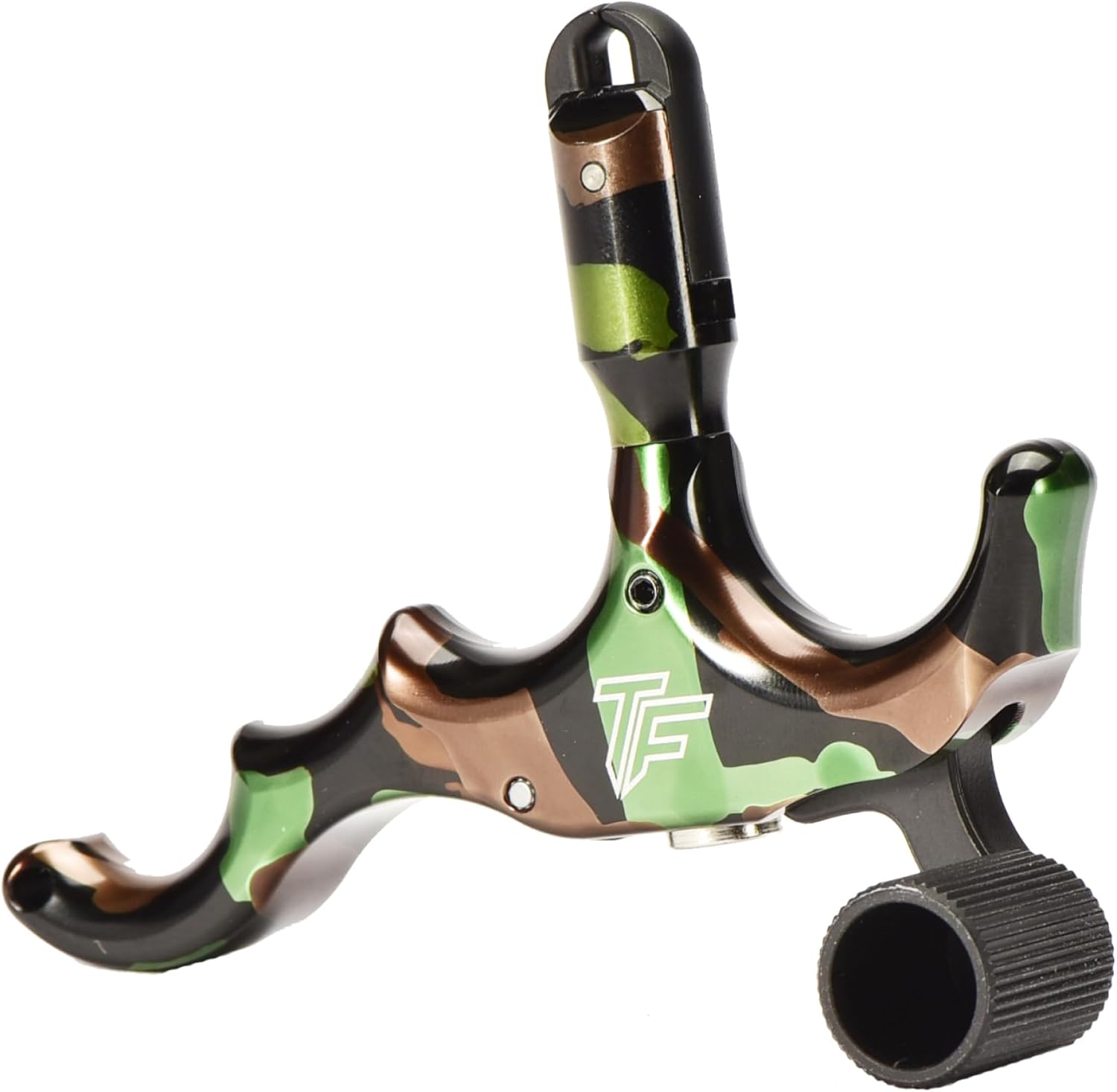Note: Our site links to archery and bowhunting products sold by outside vendors, and we may earn a small commission if you purchase an item after clicking one of these links. Learn more about our affiliate program.
Have you been on the edge of your seat, wanting to know what we think of the Tru Ball Fang bow release?
Probably not, but if so, you’re in luck: here we’ll take a deep dive into the Fang, and share what we like (and what we think is “less than optimal”). Hopefully we’ll provide you with the info you need so decide the Fang is right for your set up.
- Features full containment system
- Hook style jaw
- Hands free hunting or repetitive shooting
Before we dive into the details, let’s start with a…
SUMMARY: TRU BALL FANG REVIEW
Two thumbs up for the Fang. The Fang has some fantastic features, and in many ways—not all ways, but many—the Fang is comparable to some of the more “deluxe” bow releases that you’d see from Carter Enterprises or Spot Hogg, and we’d put it among our picks for top performers. It’s got a hook instead of calipers, it’s highly adjustable, and it’s made in both a wrist-strap and hand-held design (and for the hand-held, it’s made in a both a 3-finger and a 4-finger design). It can take a little getting used to—and you may experience a little soreness in your pointer finger when you first use it—but it’s designed for heavy, repeated usage, and for a “crisp,” low-torque release. A good solid option, in our humble opinion.
Alright, let’s jump in and take a look at the good, the bad, and the ugly:
Positives of the Fang
We’re going to discuss these in a specific order, because they build on each other. The first is the Fang’s…
Hook-Style Release. In the last few years, we’ve seen a (general) trend of archers and bowhunters moving away from caliper-style releases. Calipers were extremely popular for a very long time (and still are, really), but there are more and more archers/bowhunters using releases that feature hooks.
There are a bunch of reasons for that, including:
1) Calipers Can Chew through D-loops. Over time, the friction of the D-loop/bow string against the calipers wears the D-loop/bow string down, and that D-loop/bow string can snap on you. That wear-down may take a while, but it happens, and it can mean a surprise release of the arrow—which is certainly a bad thing—but it also means that when you release an arrow sooner than you mean to, your hand, which is no longer attached to the bow string, whips back, and you smack yourself in the mouth—which is also a bad thing, not only because it hurts, but because your friends will never let you live it down.
But wait, there’s more! When it comes to the calipers themselves…
2) The Calipers Themselves Get Worn Down Over Time. We usually think of the string getting worn out, but with enough time and usage, the calipers get worn down, and you encounter the same problem—shooting arrows before you mean to, and smacking yourself in the face. This is less likely to happen with hook releases, precisely because the D-loop/bow string rolls of the hook, instead of rubbing against it.
Caliper releases have yet another problem:
3) They Don’t Always Open Symmetrically. Proponents of caliper releases often say they’re a better choice over hook releases, because the caliper jaws open at the same and let the arrow fly without torque—whereas with a hook, the d-loop roooooooolls off the hook, and that creates some torque.
That makes sense, but it’s not how it actually works in real life, because very often the top jaw of the caliper and the bottom jaw of the caliper open at different rates—creating the same “roll” that you’d get with a hook release. At present, there’s no real way around that (but it’s so minimal, it doesn’t really make a difference any, in our humble opinion).
With all that in mind, hook-style releases offer some real advantages:
1) They Tend to be Quieter. Not a big deal for target archers or 3-D folks, but for guys and gals in a silent hunting environment—that’s a big deal.
2) They’re Easy to Hook on a D-Loop/String. Again, not a big deal for the target folks, but when you finally spot that game you’ve been looking for, you can keep your eyes on your quarry, and attach the hook to your D-loop/bow string by feel. It takes some practice, but it’s a pretty ninja move when you get it down.
3) It Creates a Smoother Arrow Release. This is, perhaps, the biggest reason hook-lovers offer: many of them swear that it provides a “cleaner”-feeling release. That may be a matter of opinion—these things are really difficult to measure—but that seems to be what most hook-users say.
So are we saying you should never use caliper-style bow releases? Absolutely not—we use a ton of them and like them a lot (particularly the Tru Fire Edge Bow Release (review), which we find very comfortable). Caliper-style bow releases can be great for beginners, and you can attach them to your bow string when you’re bow hunting and do other things, and in general, they tend to be a little less expensive than hook releases (which is a big factor for a loooooooooot of folks). We’re just letting you know, if you’re a caliper guy/gal and you wonder what’s all the hubbub about hook releases, those are the reasons.
Here’s the most important thing to remember, regardless of whether you’re using a caliper release or a hook release: sight in for the release you use, and you’ll probably be fine. No bow release is perfect, and what matters most is tuning your bow to be accurate with the release that you’ve chosen. In the end, regardless of whether you use a hook release or a caliper release, what’s really important is that you tune your bow to be accurate with that release.
OK! Know you know. With all that in mind, we think the next feature is:
Hook Release PLUS D-Loop Capture. Here’s the real stand-out feature of the Tru Ball Fang bow release: it’s a hook-style release that’s *also* a containment-style release. If you look, the hook is actually met by a little piece of material that works to fully encapsulate the D-loop/bow string
- Features full containment system
- Hook style jaw
- Hands free hunting or repetitive shooting
That means that you get all the advantages of a hook-style release, but you can also attach it to your bowstring, and then do other tasks—go and retrieve your arrows at the range, climb a tree stand and get yourself situated, whatever. When a hook style release doesn’t have that attachment, you can’t leave it on the D-loop/bow string, because it would fall off.
So that’s really cool, and if we had to guess—and we could most certainly be wrong—but we think we’ll see a lot more of these “hook + containment” designs in the future. They really offer most of the functionality that we hope to see in a release that you can use for target shooting and bow hunting.
Manufactured in Both Wrist Strap and Hand-Held. If we had one wish for all bow releases, it’s that manufacturers would start making them in different styles. So often, you’ll find a release that you really like—it has all the features you want, and its release mechanism works for you—but you want a hand-held release and it’s only made as a wrist release, or vice versa. We absolutely love that Tru Fire makes the hand-held version, as well as the TRU Ball FANG Buckle.
Unfortunately, Tru Fire doesn’t do this for all their releases—and we imagine there’s business-related reasons for doing so—but we really like that they make this is both main styles.
Made in a 3-Finger and 4-Finger Variety. This, of course, refers to the hand-held version. Propers to Tru Ball for offering more variety. The difference between a 3-finger and a 4-finger is pretty clear (3-fingers offer a little less stability but feel a little less clunky; 4-fingers are easier to grip, but can feel a little cumbersome). Neither one lends itself to more accuracy, but most people have a preference for one or the other.
So, we appreciate that both are made. The only other manufacturers that make their bow releases in such a wide range of styles (at present, anyway) are Carter (check here for a review of their releases) and Spot Hogg (check here for a review of the Whipper Snapper, which also features 3-finger/4-finger designs).
It’s Very Adjustable. This is the other feature that you’ll frequently find in well-made bow releases: it’s got a lot of adjustment options. We won’t go into too much depth here, because it’s pretty straight-forward, but the Fang offers travel adjustment on the trigger—you can adjust it so that it is very light, and releases arrows without much provocation—and you can adjust the barrel (the actual triggering mechanism) to be nearer or farther away from your thumb. Adjustability is one of those features that can make or break a release, so it’s nice to see it here.
Criticisms of the Fang
Our Tru Ball Fang review wouldn’t be complete if we didn’t mention the following two complaints. They’re not terrible, but they’re things you should know:
The “Feel” Make Take Some Getting Used To. Above, we wrote that the Fang can complete with some of the more “deluxe” bow releases that you’d see from Carter release or Spot Hogg. It’s important to note that while there are a lot of similarities, and the Fang does “punch above its weight,” so to speak, there’s one aspect of the Fang that doesn’t measure up to those big boys: the “feel” of the release.
And, yes, this is subjective, but it’s something you may hear about this particular release. If you look at the way it’s shaped, it seems to put a lot of pressure on your pointer finger when you draw back the bow string. With repeated use, that can make your pointer finger feel a little sore.
The good news is, that soreness frequently goes away after you get used to the release. Think of it like a stiff new pair of sneakers—they hurt your feet for the first few days, but after walking a few miles in them, your feet usually adjust.
So, again—it’s not a dealbreaker by any means, but it’s a common complaint with the Fang, and some people don’t appreciate that, and it may take a little while for it to feel natural.
You May Need to Re-Pull the Trigger to Reset the Hook. That’s kind of a bummer—it’s very nice to use a release that automatically resets after you use it. It’s just one less thing you have to think about during the draw cycle. Again, not the biggest deal in the world, but something we hope that change if they make another iteration of the Fang.
A Quick Note About the Name “Fang”
If you’ve read any of our reviews, you’ll noticed we’re endlessly amused by the names of archery products, and particularly bowhunting products. They’re creative and interesting and sometimes silly.
The “Fang” is actually an interesting name—it probably refers to the hook on the bow release, because it kind of resembles a snake fang, hence “Fang.” But as you probably know, and fang is a sharp tooth commonly used to tear flesh, so it seems like it would make more sense to name a broadhead “Fang.” So it’s kind of an interesting name, and maybe not what we’d choose.
But that’s neither here nor there. All in all, we give the Fang high marks, and we think it offers a little more than other bow releases in this range.
We hope that helps—have fun, be good, and happy bow releasing!
- Features full containment system
- Hook style jaw
- Hands free hunting or repetitive shooting






